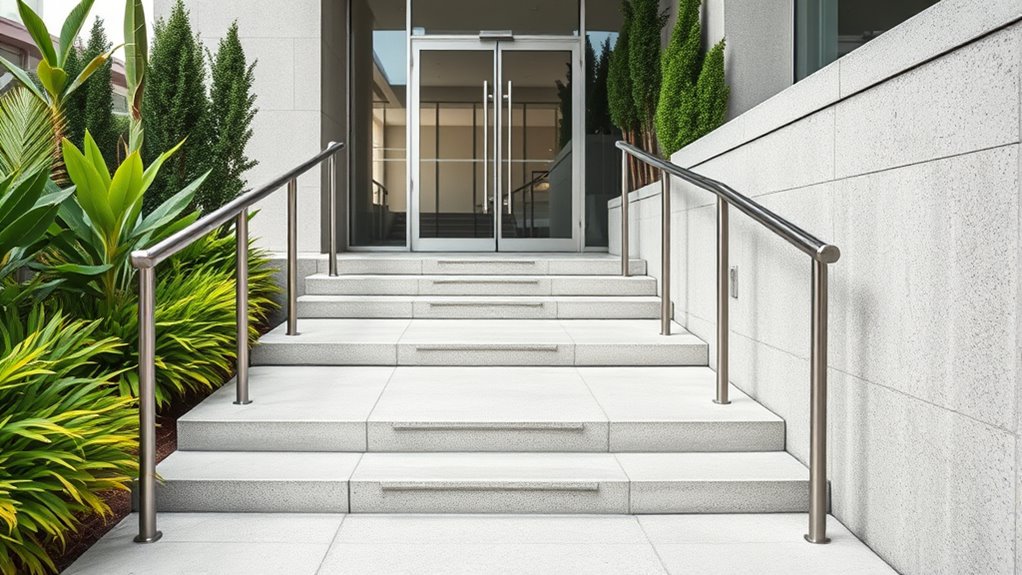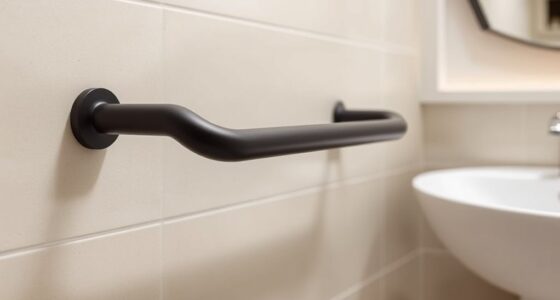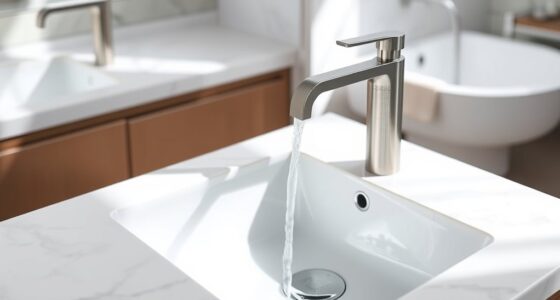To make your entryway accessible, replace stairs with a smooth, gentle ramp that suits your space and safety needs. Widening doors allows easier passage for wheelchairs or walkers, making your home more inclusive. Consider adding handrails or non-slip surfaces for extra safety. Proper planning and professional help ensure these upgrades meet safety standards. If you want to discover more about creating welcoming, accessible entrances, keep exploring how these improvements can transform your home.
Key Takeaways
- Installing ramps replaces stairs with gentle slopes, easing access for wheelchairs, strollers, and mobility aids.
- Widening doorways ensures unobstructed entry for various mobility devices and large items.
- Incorporating safety features like handrails and non-slip surfaces enhances overall accessibility and security.
- Proper planning and professional guidance ensure modifications meet safety standards and blend with home aesthetics.
- Accessibility upgrades foster independence, inclusivity, and a welcoming environment for all residents and visitors.

Accessible entryways are essential for creating safe and inclusive homes for everyone. Whether you’re welcoming guests or ensuring daily comfort, making entry points accessible removes barriers that can hinder mobility. One of the most effective ways to achieve this is through ramp installation. Ramps provide a smooth, gentle incline that replaces stairs, making it easier for wheelchairs, walkers, and even strollers to navigate entryways effortlessly. When planning a ramp, consider the height difference, available space, and safety features like handrails and non-slip surfaces. A well-designed ramp not only enhances safety but also seamlessly integrates into your home’s aesthetic, making the shift from outside to inside feel natural and welcoming.
Accessible entryways promote safety and inclusion through ramps that seamlessly blend with your home’s aesthetic.
Alongside ramp installation, door widening plays a vital role in accessibility. Standard doorways often aren’t wide enough to accommodate mobility aids, creating obstacles that can make entering or exiting your home difficult. By widening doors, you open up your space, allowing for easier passage for wheelchairs and mobility scooters. This process involves removing or modifying the existing door frame and possibly adjusting nearby walls to ensure a comfortable, unobstructed opening. It’s a smart upgrade that benefits not only those with mobility challenges but also makes moving furniture or large items in and out of your home much simpler. Door widening can be tailored to match your home’s style, ensuring your entryway remains both functional and visually appealing.
Implementing both ramp installation and door widening requires some planning, but the benefits far outweigh the effort. These modifications foster independence and security, giving everyone the confidence to move freely. You might also consider combining these upgrades with other adjustments, like threshold ramps or lever-style door handles, to create an even more accessible environment. It’s important to work with professionals who understand accessibility standards, making certain that every change meets safety codes and provides maximum usability. Doing so guarantees that your home remains welcoming and safe for all visitors and residents, regardless of mobility level.
Ultimately, transforming your entryway from steps to a smooth, accessible threshold is about more than just convenience—it’s about demonstrating care and inclusivity. When you prioritize accessible entryways, you’re making a statement that everyone’s comfort and safety matter. Whether it’s through thoughtful ramp installation or widening doors, these upgrades help create a home where all people can come and go with ease, dignity, and confidence. Taking advantage of specialized accessibility solutions can further customize your modifications to fit your specific needs. Making these improvements might require some investment, but the sense of independence and peace of mind you gain is truly priceless.
Frequently Asked Questions
What Are the Cost Considerations for Modifying Entryways?
When considering modifying entryways, you should perform a thorough cost analysis to understand expenses involved. Budget planning helps you allocate funds effectively, covering materials, labor, and potential permits. Keep in mind that upgrades like ramps or widened doorways can vary in cost depending on the scope of work. By evaluating these factors early, you guarantee your project stays within budget while creating an accessible, functional entryway for everyone.
How Do I Choose the Best Accessibility Options for My Home?
When choosing accessibility options for your home, consider both home security and aesthetic appeal. You want solutions that enhance safety without compromising style. Think about low-threshold ramps or wide doorways that blend seamlessly with your decor. Prioritize easy-to-use features that suit your daily needs and provide peace of mind. Visit showrooms or consult professionals to find options that balance functionality, security, and visual harmony, making your entryway both safe and attractive.
Are There Specific Building Codes for Accessible Entrances?
Did you know that over 60% of home modifications for accessibility are driven by building code compliance? When planning accessible entrances, you must follow specific building codes for safety and functionality. Accessibility standards guarantee your entryway is safe and usable for everyone. Always check local regulations, as codes vary, and ensure your design meets these standards to avoid future issues and promote inclusivity.
Can Existing Entryways Be Retrofitted Easily?
You can often retrofit existing entryways by focusing on threshold modifications and increasing door width. Start by evaluating the current threshold and making adjustments to eliminate steps or uneven surfaces. Widening the doorframe may require minor structural changes but generally isn’t too complex. With these modifications, you make entryways more accessible, helping everyone navigate smoothly. Always check local building codes to ensure your renovations meet accessibility standards.
What Materials Are Most Durable for Accessible Ramps?
When considering materials for accessible ramps, durability, longevity, and safety top your list. You’ll want options like concrete, which offers unmatched strength and weather resistance; steel, known for its durability and load-bearing capacity; and composite materials, which resist corrosion and require minimal maintenance. These choices ensure your ramp remains sturdy over time, providing reliable access and reducing replacement costs, ultimately maximizing material resilience and ramp lifespan.
Conclusion
Now, imagine opening your door to a world where every step is gentle and inviting. With a few simple changes, your entryway transforms into a welcoming gateway, free of obstacles and full of possibility. Feel the smooth surface under your hand, the open space inviting you in. Every detail, crafted with care, turns your threshold into a seamless passage—an embrace that welcomes all, making your home truly accessible and inviting for everyone who enters.









